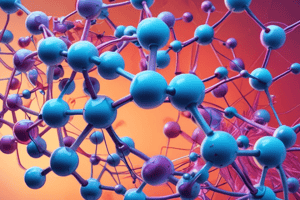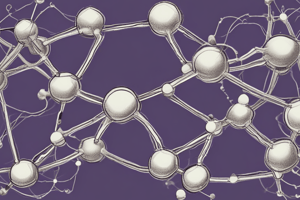Podcast
Questions and Answers
What is the correct pronunciation of sp3 hybrid orbital?
What is the correct pronunciation of sp3 hybrid orbital?
- squared-p-3
- s-p-to-the-power-of-3
- s-p-3
- s-p-cubed (correct)
How many orbitals are formed when one s orbital and three p orbitals combine to create sp3 hybrid orbitals?
How many orbitals are formed when one s orbital and three p orbitals combine to create sp3 hybrid orbitals?
- 4 (correct)
- 3
- 1
- 2
What is the maximum number of electrons that a p orbital can hold?
What is the maximum number of electrons that a p orbital can hold?
- 4
- 2
- 8 (correct)
- 6
What shape does the resulting hybrid orbital form when the spherical s orbital interacts with the p orbital to create sp3 hybrid orbitals?
What shape does the resulting hybrid orbital form when the spherical s orbital interacts with the p orbital to create sp3 hybrid orbitals?
Which type of hybridization is exemplified by boron trifluoride?
Which type of hybridization is exemplified by boron trifluoride?
What does Molecular Orbital Theory predict about the location of electrons in a molecule?
What does Molecular Orbital Theory predict about the location of electrons in a molecule?
How do different atomic orbitals contribute to molecular orbital shapes?
How do different atomic orbitals contribute to molecular orbital shapes?
What is the result of combining atomic orbitals into molecular orbitals according to Molecular Orbital Theory?
What is the result of combining atomic orbitals into molecular orbitals according to Molecular Orbital Theory?
What is the shape of the sp3 orbital and its bond angles?
What is the shape of the sp3 orbital and its bond angles?
What type of bond involves two hybrid orbitals overlapping?
What type of bond involves two hybrid orbitals overlapping?
In a triple bond, what type of hybridization results in two sp orbitals and two p orbitals forming pi bonds?
In a triple bond, what type of hybridization results in two sp orbitals and two p orbitals forming pi bonds?
What is the hybridization of carbon atoms in acetylene (C2H2)?
What is the hybridization of carbon atoms in acetylene (C2H2)?
What is the bond order of a molecule with 10 electrons in bonding molecular orbitals and 6 electrons in anti-bonding orbitals?
What is the bond order of a molecule with 10 electrons in bonding molecular orbitals and 6 electrons in anti-bonding orbitals?
Which theory explains the strength difference between sigma and pi bonds, and why double and triple bonds are not twice or thrice as strong as single bonds?
Which theory explains the strength difference between sigma and pi bonds, and why double and triple bonds are not twice or thrice as strong as single bonds?
What type of bond involves the overlapping of outermost electron orbitals of metal atoms, allowing for the free movement of electrons?
What type of bond involves the overlapping of outermost electron orbitals of metal atoms, allowing for the free movement of electrons?
What is the unique bonding model in metallic bonding that allows the free movement of electrons, contributing to properties vital to human survival?
What is the unique bonding model in metallic bonding that allows the free movement of electrons, contributing to properties vital to human survival?
What contributes to the strength of metallic bonds?
What contributes to the strength of metallic bonds?
Why do metals have high boiling points?
Why do metals have high boiling points?
What property of metals allows them to provide electricity to buildings and other items?
What property of metals allows them to provide electricity to buildings and other items?
What is an alloy?
What is an alloy?
What contributes to the high boiling points of metals?
What contributes to the high boiling points of metals?
What property of metals allows them to be stretched and drawn into long, thin wires?
What property of metals allows them to be stretched and drawn into long, thin wires?
What property of metals allows them to conduct electricity?
What property of metals allows them to conduct electricity?
What is the result of blending metals to create alloys?
What is the result of blending metals to create alloys?
What type of bond is formed in metallic bonding?
What type of bond is formed in metallic bonding?
What property allows metals to be stretched and drawn into long, thin wires?
What property allows metals to be stretched and drawn into long, thin wires?
What contributes to the luster exhibited by metals?
What contributes to the luster exhibited by metals?
What allows metals to conduct electricity?
What allows metals to conduct electricity?
Flashcards are hidden until you start studying
Study Notes
Hybrid Orbitals and Bonding
- Orbital shapes (s, p, d) are conserved when hybrid orbitals form
- Hybrid orbitals can be formed from s and d orbitals, creating a bow-tie shape
- Hybrid orbitals contain electrons in constant motion and allow for bonding with other elements
- Hybrid orbitals create a three-dimensional shape due to repulsion between electrons
- The sp3 orbital has four hybrid orbitals and forms a 3D tetrahedron shape with 109.5° bond angles
- Understanding hybridization allows visualization of covalent bond formation
- Ethane (CH3CH3) consists of two carbon atoms and six hydrogen atoms forming single covalent bonds
- Determining hybridization (sp3, sp2, or sp) depends on the number of atoms bound and the type of bond
- Single, double, and triple bonds are formed based on the number of atoms bound and the type of hybridization
- A sigma bond occurs with two hybrid orbitals overlapping, while a pi bond involves unhybridized p orbitals
- In a triple bond, sp hybridization results in two sp orbitals and two p orbitals forming pi bonds
- Acetylene demonstrates the triple bond and sp hybridization, resulting in two pi bonds and a stronger, shorter bond.
Molecular Orbital Theory and Metallic Bonding
- Electrons are assigned from lower to higher energy orbitals, and similar energy orbitals create stronger bonding orbitals
- Molecular Orbital (MO) theory provides a comprehensive understanding of how atoms bond, including bond strength and bond order
- Valence bond theory does not explain the strength difference between single and double bonds or the occurrence of bond structures with a bond order of 1.5
- Bond order, describing the type of bond between atoms, is calculated by adding electrons in bonding molecular orbitals and subtracting anti-bonding orbitals, then dividing by two
- MO theory differentiates between the strength of sigma and pi bonds, explaining why double and triple bonds are locked in place and not twice or thrice as strong as single bonds
- Bond strength is related to bond order and the energy gaps between bonding and anti-bonding orbitals, influencing the energy required to break a bond
- MO diagrams visualize orbitals, relative bond strength, and bond characteristics, demonstrating the impact of different electronegativities on bond character
- Metallic bonding involves the overlapping of outermost electron orbitals of metal atoms, allowing for the free movement of electrons, and is unique to metals
- Ionic bonds form between a metal and a non-metal, while covalent bonding occurs between non-metal atoms through the sharing of electron pairs
- Metals constitute over 80% of the periodic table, and metallic characteristics decrease somewhat from right to left toward the metalloids
- The sea of electrons bonding model, unique to metallic bonding, allows the free movement of electrons, contributing to properties vital to human survival such as the crystalline lattice configuration
- Metal atoms arrange their structure in a crystalline lattice configuration, enabling orbital overlap and providing a solid structure for electrons to travel along, with low intermolecular energy
Studying That Suits You
Use AI to generate personalized quizzes and flashcards to suit your learning preferences.




